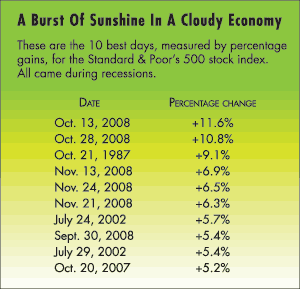Amid the stock market carnage of 2008, the natural inclination of many investors was to run and hide. But that kind of emotional reaction could work against your own long-term interests. Historically, the best time to invest in the stock market has been when the economy is in the dumps. Investors who wait for conditions to improve before buying stocks are likely to miss the first leg of a bull market—and that, over the long haul, could be extremely costly.
Past performance is no guarantee of future results, and this recession has been one of the worst in history. So while market has rallied from the March 2009 lows, the future is still uncertain. But during the past nine recessionary periods, beginning in the 1950s, the stock market has staged rousing comebacks that started while the economy was still struggling.
 If you pinpoint the statistical low point of each of those recessions and measure the performance of the Standard & Poor’s 500 stock index until six months after the downturn’s end, you’ll find returns averaging 36%. And several rallies greatly exceeded that average. If you pinpoint the statistical low point of each of those recessions and measure the performance of the Standard & Poor’s 500 stock index until six months after the downturn’s end, you’ll find returns averaging 36%. And several rallies greatly exceeded that average.
During and after the recession of 1953 to 1954, the S&P gained 51% in a little more than a year, and coming out of the recession of 1981 to 1982, the market surged 59%.
While we can only know this recession’s low point in retrospect, it officially began in December 2007, and so has already exceeded the average 11-month length of those previous post-World War II recessions.
Most of the market’s best days, in fact each of the top-10 one-day gains in percentage terms, came while recessions raged. Many of those spikes came in late 2008, amid extreme market volatility, and while the broad market was losing almost 40%. Again, to judge by past events, missing the market’s sharpest rallies can really hurt long-term performance.
Given that accurately timing market moves is virtually impossible, the best way to avoid missing out on a market rebound is to have a sensible, long-term investment plan that keeps you invested throughout the market’s ups and downs. By staying invested, you will undoubtedly suffer on the down days, but you’ll be sure to enjoy a share of the 80% to 90% of market gains that occur over less than 10 percent of the trading days.
During those aforementioned nine recessionary periods, looking at the performance of the stock market from six months before the recession until six months afterward, stocks averaged a gain of 8%*. So, as painful as it is to watch the value of your holdings tumble, you can take comfort in that, over the long haul, the market recovers and moves higher than it was before the economy tanked. |
 Printer Friendly Version
Printer Friendly Version